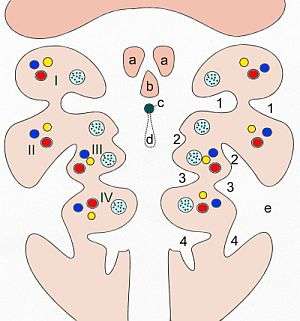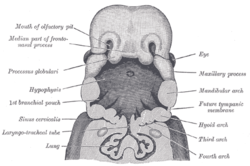Cervical sinus
During human embryogenesis, the mandibular arch and hyoid arch grow more rapidly than those behind them, with the result that the latter become, to a certain extent, telescoped within the former, and a deep depression, the cervical sinus, is formed on either side of the neck.
| Cervical sinus | |
|---|---|
 Scheme of the pharyngeal arches
| |
| Details | |
| Identifiers | |
| Latin | sinus cervicalis |
| Anatomical terminology | |
This sinus is bounded in front by the hyoid arch, and behind by the thoracic wall; it is ultimately obliterated by the fusion of its walls.
Sometimes, it can remain anterior to the sternocleidomastoid muscle. It can communicate with the skin (external cervical fistula) or with the pharynx (internal cervical fistula). It is prone to infection.
Additional images
 The head and neck of a human embryo 32 days old, seen from the ventral surface
The head and neck of a human embryo 32 days old, seen from the ventral surface
gollark: There's one company which claims to have solved the display problem through sorcerous optics of some kind, but I don't know how true their claims are.
gollark: Anyway, I'm hoping consumer AR-type things come before neural interfaces, and this seems fairly plausible right now.
gollark: Oh yes, just remove wires surgically implanted in your brain casually.
gollark: They could just mind-control me into recharging it.
gollark: If someone gets access to a computer in my *brain*, they can alter my beliefs and perceptions - subject me to horrible torture forever, make me an entirely different person, sort of thing.
References
This article incorporates text in the public domain from page 67 of the 20th edition of Gray's Anatomy (1918)
This article is issued from Wikipedia. The text is licensed under Creative Commons - Attribution - Sharealike. Additional terms may apply for the media files.